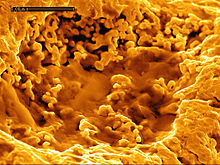Cupriavidus metallidurans
| Cupriavidus metallidurans | |
|---|---|
| Scientific classification | |
| Domain: | |
| Phylum: | |
| Class: | |
| Order: | |
| Family: | |
| Genus: | |
| Binomial name | |
| Cupriavidus metallidurans (Goris et al. 2001) Vandamme and Coenye 2004
| |
| Type strain | |
| ATCC 43123, aka CH34 | |
| Synonyms | |
(Not distinguished from Ralstonia eutropha until 2001.)[2] | |
Cupriavidus metallidurans is a non-spore-forming, Gram-negative bacterium which is adapted to survive several forms of heavy metal stress.[3][4][5]
As a model and industrial system
[edit]Cupriavidus metallidurans is a bacterial species that belongs to the same family as Ralstonia solanacearum, a plant pathogen.[6]
This species is of ecological and industrial importance, as its relatives dominate mesophilic environments contaminated with heavy metals.[2][7] C. metallidurans is used in the industrial sector for both heavy metal remediation and sensing.[4]
This aerobic chemolithoautotroph is capable of growing in a mineral salts environment with H2, O2, and CO2 without an organic carbon source.[8] Its energy-providing subsystem is composed of only the hydrogenase, the respiratory chain, and the F1F0-ATPase, which remain separate from the anabolic subsystems.
C. metallidurans can also degrade xenobiotics in conditions with high levels of heavy metals.[9]
Strain CH34 has adapted to these harsh conditions through multiple heavy-metal resistance systems, encoded by the two indigenous megaplasmids, pMOL28 and pMOL30, on its chromosome(s).[3][4][10]
Ecology
[edit]
C. metallidurans plays a vital role, together with Delftia acidovorans, in the formation of gold nuggets. It precipitates metallic gold from a solution of gold(III) chloride, a compound highly toxic to most other microorganisms.[11][12][13]
As a pathogen
[edit]A case of a 74 year old man infected with Cupriavidus metallidurans has been documented,[14] possibly raising concerns about the safety of using the bacteria for industrial purposes.
References
[edit]- ^ Vandamme, P.; T. Coeyne (June 18, 2004). "Taxonomy of the genus Cupriavidus: a tale of lost and found". International Journal of Systematic and Evolutionary Microbiology. 54 (Pt 6): 2285–2289. doi:10.1099/ijs.0.63247-0. PMID 15545472.
- ^ a b Goris, J.; et al. (2001). "Classification of metal-resistant bacteria from industrial biotopes as Ralstonia campinensis sp. nov., Ralstonia metallidurans sp. nov. and Ralstonia basilensis Steinle et al. 1998 emend". Int J Syst Evol Microbiol. 51 (Pt 5): 1773–1782. doi:10.1099/00207713-51-5-1773. PMID 11594608.
- ^ a b Nies, DH (1999). "Microbial heavy metal resistance". Appl Microbiol Biotechnol. 51 (6): 730–750. doi:10.1007/s002530051457. PMID 10422221. S2CID 6675586.
- ^ a b c Nies, DH (2000). "Heavy metal resistant bacteria as extremophiles: molecular physiology and biotechnological use of Ralstonia spec. CH34". Extremophiles. 4 (2): 77–82. doi:10.1007/s007920050140. PMID 10805561. S2CID 11156112.
- ^ Ryan, Michael P.; Adley, Catherine C. (2011-09-01). "Specific PCR to identify the heavy-metal-resistant bacterium Cupriavidus metallidurans". Journal of Industrial Microbiology & Biotechnology. 38 (9): 1613–1615. doi:10.1007/s10295-011-1011-y. ISSN 1476-5535. PMID 21720772. S2CID 33552248.
- ^ Salanoubat M.; et al. (2002). "Genome sequence of the plant pathogen Ralstonia solanacearum". Nature. 415 (6871): 497–502. doi:10.1038/415497a. PMID 11823852.
- ^ Diels, L.; Q. Dong; D. van der Lelie; W. Baeyens; M. Mergeay (1995). "The czc operon of Alcaligenes eutrophus CH34: from resistance mechanism to the removal of heavy metals". Journal of Industrial Microbiology. 14 (2): 142–153. doi:10.1007/BF01569896. PMID 7766206. S2CID 29272445.
- ^ Mergeay, M.; D. Nies; H.G. Schlegel; J. Gerits; P. Charles; F. van Gijsegem (1985). "Alcaligenes eutrophus CH34 is a facultative chemolithotroph with plasmid-bound resistance to heavy metals". Journal of Bacteriology. 162 (1): 328–334. doi:10.1128/JB.162.1.328-334.1985. PMC 218993. PMID 3884593.
- ^ Springael, D.; L. Diels; L. Hooyberghs; S. Kreps; M. Mergeay (1993). "Construction and characterization of heavy metal resistant haloaromatic-degrading Alcaligenes eutrophus strains". Appl Environ Microbiol. 59 (1): 334–339. doi:10.1128/AEM.59.1.334-339.1993. PMC 202101. PMID 8439161.
- ^ Monchy, S.; M.A. Benotmane; P. Janssen; T. Vallaeys; S. Taghavi; D. van der Lelie; M. Mergeay (October 2007). "Plasmids pMOL28 and pMOL30 of Cupriavidus metallidurans are specialized in the maximal viable response to heavy metals". Journal of Bacteriology. 189 (20): 7417–7425. doi:10.1128/JB.00375-07. PMC 2168447. PMID 17675385.
- ^ Reith, Frank; Stephen L. Rogers; D. C. McPhail; Daryl Webb (July 14, 2006). "Biomineralization of Gold: Biofilms on Bacterioform Gold". Science. 313 (5784): 233–236. Bibcode:2006Sci...313..233R. doi:10.1126/science.1125878. hdl:1885/28682. PMID 16840703. S2CID 32848104.
- ^ Superman-Strength Bacteria Produce 24-Karat Gold
- ^ The bacteria that turns toxic chemicals into pure gold
- ^ Langevin, Stéphanie; Vincelette, Jean; Bekal, Sadjia; Gaudreau, Christiane (February 2011). "First Case of Invasive Human Infection Caused by Cupriavidus metallidurans". Journal of Clinical Microbiology. 49 (2): 744–745. doi:10.1128/JCM.01947-10. ISSN 0095-1137. PMC 3043494. PMID 21106795.
